Parades, Flags and Rallies: Celebrating Singapore’s National Day
National Day parades have been a ubiquitous part of Singapore’s National Day celebrations since Independence. Lim Tin Seng delves into its history, its significance and its evolution.
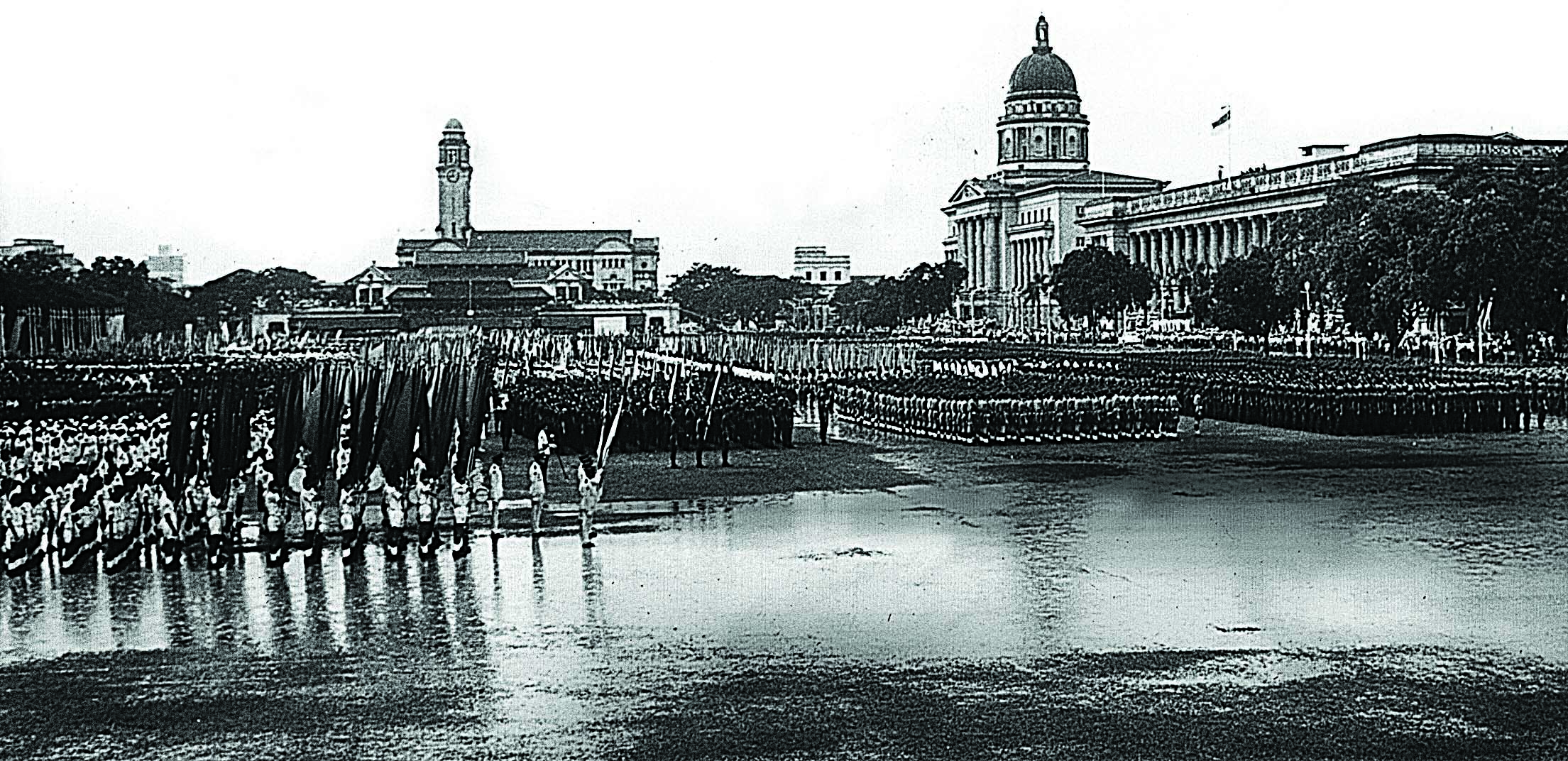 The 1968 National Day Parade carried on despite torrential rain. Yusof Ishak collection, courtesy of National Archives of Singapore.
The 1968 National Day Parade carried on despite torrential rain. Yusof Ishak collection, courtesy of National Archives of Singapore.Since becoming a sovereign state on 9 August 1965, the Singapore government has introduced numerous nation-building efforts – with varying degrees of success – to remind Singaporeans of their national identity. But none is more visceral and engaging than the annual National Day Parade (NDP), which draws patriotic flag-waving Singaporeans by the thousands to this colourful outdoor event. Held on 9 August each year, the parade not only commemorates Singapore’s Independence, but also serves to remind people of the country’s struggles and successes and to celebrate its unique multicultural identity. The main organiser of the NDP is the Singapore Armed Forces (SAF) and its preparation, from initial blueprint to full dress rehearsal, typically takes more than six months.
Besides the NDP, a series of ancillary National Day events such as community activities in the heartlands and the National Day Rally (the annual address of the Prime Minister of Singapore on the state of the nation) are also organised each August.
National Day Parades
Every NDP is marked by military and civilian processions, mass cultural performances, grand parades of the national colours and spectacular fireworks displays. Singapore has enjoyed a series of majestic visual spectacles of parades since its colonial days where grand receptions were held regularly to celebrate the birthdays and coronations of British monarchs.1 However, what sets the parades of both eras apart are their significance: colonial parades were held to celebrate the might of the British Empire; NDPs are orchestrated to highlight the aspirations and ideals of the fledgling nation to the people.
NDPs of the immediate post-independence years aimed to instil a sense of pride and responsibility in the people as citizens of a new nation.2 To the government, this meant building a “rugged society”, or as then Prime Minister Lee Kuan Yew envisaged, a generation of people who were hardworking, self-sacrificing and willing to live a lean, hard life for the country.3 In line with this, the NDPs of the 1960s articulated themes such as “Rugged and Vigorous Singapore” (1967), “Rugged Society” (1968), and “Youth and Discipline” (1969).4 Ironically, the 1968 parade’s theme of ruggedness was portrayed literally as it carried on despite a fierce thunderstorm. The experience was so enduring that television broadcasting station, Mediacorp, produced a drama series in 2012 based on the episode.5 The 1969 parade was equally inspiring as the first mobile column comprising 18 AMX-13 tanks joined the march-past. As Singapore was the first country in the region to acquire such military hardware, it conveyed the message that Singapore was not going to be cowed by its stronger neighbours in the region.6
The parades of the 1970s focused on the country’s human capital, with themes such as “Work for Security and Prosperity” (1970), “Productivity and Progress” (1972) and “Self-Reliance” (1976). These parades were fitting tributes to Singapore’s manpower as they commemorated the contributions and sacrifices made for the economy which, at the time, registered double-digit growth rates.7 To boost the morale of the workforce and to highlight its importance to the nation, the number of contingents from civilian groups, particularly those from the workforce, were featured more prominently. In 1976, contingents representing the “builders” of post-independence Singapore took part in the march-past. Some of these contingents included workers from the Keppel Shipyard, Intraco, Port of Singapore Authority as well as Jurong Bird Park and Singapore Airlines.8
NDPs began taking a more populist approach from the 1980s. Instead of regimented displays of marching and dance routines, the parades morphed into large-scale extravagant cultural events complete with striking visual imagery and dramatic action.9 For instance, the mass performance portions were marked by fireworks, laser displays and flashcard shows that created complex mosaic patterns and images with patriotic narratives. The military no longer simply displayed moving exhibitions of men and equipment; spectators were now treated to action-packed stunts by the SAF.10
One reason for the reorientation of the parades was to make them more engaging so that people from all walks of life could come together to celebrate the country’s achievements. In fact, the performances, dances and pattern formations in the mass display segments, often led by local celebrities, are designed to draw the public’s attention to the nation’s ideals and identity.11 This populist theme in NDPs was further complemented by the introduction of national songs such as Singapura, Oh Singapura (1980), There’s a Part for Everyone (1984), Stand up for Singapore (1985), Count on Me, Singapore (1986), We are Singapore (1987), We are the People of Singapore (1989), and One People, One Nation, One Singapore (1990). Composed by local contemporary songwriters, these pop songs contain lyrics that help define the Singapore identity through the nation’s struggles and success.12 The Ministry of Communications and Information commented in 1988:
“Singing the songs will bring Singaporeans together, to share our feelings with one another. It will bring back shared memories of good times and hard times, of times which remind us of who we are, where we come from, what we did, and where we are going.”13
Today, the parades continue to be highly anticipated by Singaporeans. In fact, before the e-balloting system to allocate NDP tickets was introduced in 2003, it was not unusual to see people camping overnight at distribution centres for tickets. As the tickets were usually sold out within minutes, there would be a mad scramble the moment the centres opened their doors.14
THE FIRST NATIONAL DAY
Singapore’s first National Day was held on 4 June 1960, one year after it achieved self-government. However, the ensuing parade, which was to have included a march-past and mass rally, was cancelled due to heavy rain disappointing the 25,000 participants who had turned up. Fortunately, the National Day celebration was a three-day event and thanks to clear skies the following day, more than 22,000 people, including then Yang di-Pertuan Negara Yusof Ishak, then Prime Minister Lee Kuan Yew and members of the Cabinet crowded into Jalan Besar stadium for a spectacular tattoo that was filled with rhythmic drills, music, singing, dances and displays of military prowess.
Decentralising the Celebrations
Traditionally NDPs were held in two centralised locations, the Padang and the National Stadium. After the National Stadium closed in 2006 to make way for a new stadium, The Float at Marina Bay became another NDP venue.15 The first ever NDP was held at the Padang, the historic field opposite City Hall. NDP in its early days was a simple march-past involving some 23,000 participants. Starting at nine in the morning with the arrival of President Yusof Ishak, the parade only lasted 90 minutes.16 The next nine NDPs were held at the Padang until 1975 when the government decided to decentralise the celebration, holding it at different parts of island in the form of “pocket pageants”. The aim was to bring the parades “closer to the people” so that they could have “the opportunity of witnessing the pomp and pageantry” at their doorsteps.17
In the first decentralised NDP in 1975, 13 venues across Singapore, including Farrer Park, Jalan Besar, Jurong, Paya Lebar, Redhill, Toa Payoh and Queenstown, were chosen to host the smaller scale parades.18 The programme for each venue included the usual march-past by military and civilian contingents, performances by students and cultural troupes from the different ethnic groups and fireworks displays in the evening.19 To emphasise the inclusiveness of the parades, the Prime Minister and his cabinet members spread themselves across the various locations to participate in the celebrations and mingle with the people.20 The decentralised parades were held every alternate year until 1984 when the government decided to return to the concept of having one parade at a single location. This was partly due to the high cost of duplicating the parades, the difficulty of coordination and the challenges the parades posed for live television broadcasting.21
In 2010, the decentralised concept was revived when organisers of NDP 2010 decided to extend celebrations from the Padang to five suburban locations – Choa Chu Kang, Bishan, Eunos, Sengkang and Woodlands.22 Dubbed the Heartland Celebrations, the rationale behind the decision was similar to the original concept. It was to bring the parade closer to the people so that they could come together to celebrate the unity of the nation.23 The Heartland Celebrations were filled with performances, activities, pyrotechnic displays and fireworks. The 200-vehicle strong mobile column also fanned out to the five locations after the Padang drive-past.24
Bringing the parades to the people is only one aspect of the decentralised concept. Since the first NDP in 1966, parades have been broadcast live on television so that people can enjoy the celebrations from the comfort of their homes. The earlier broadcasts were in black-and-white until colour television was introduced in 1974.25 Since 1994, the parades have been streamed live via the Internet, allowing overseas Singaporeans to be a part of the celebrations.26 In 2007, the webcast was enhanced to allow viewers to enjoy the parade from multiple camera angles.27 In 2010, an NDP app was developed. Using Augmented Reality, the app provides users with trivia on the parade and allows them to post their thoughts on its “expression wall”.28
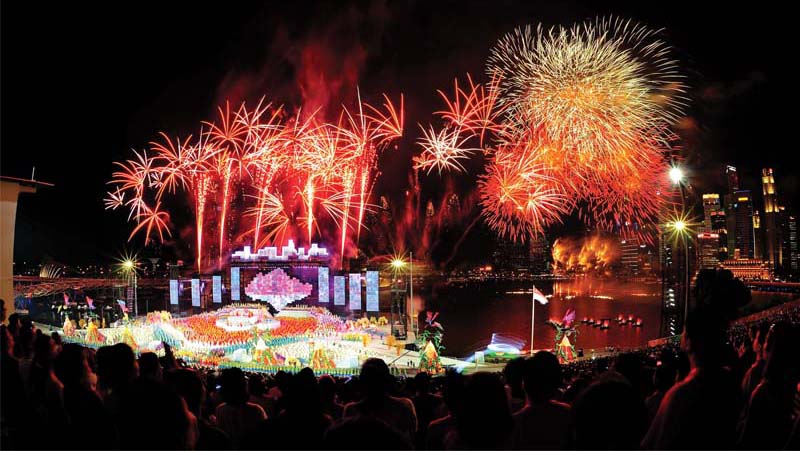 National Day celebration in 2012. National Day celebrations in Singapore have evolved over the years and have become a grand visual spectacle. Image by Jordan Tan.
National Day celebration in 2012. National Day celebrations in Singapore have evolved over the years and have become a grand visual spectacle. Image by Jordan Tan.Roadshows and exhibitions are organised in the heartlands to explain the meaning of the celebration to the people.29 These NDP roadshows move to different locations in Singapore and showcase exhibits that deepen the people’s understanding of Singapore and its identity. In addition, the organisers and participants regularly publish commemorative books or magazines that share their NDP experiences, from planning and rehearsals to the actual performances, among other memories.30
In addition to these activities, the use of nationalist images on commemorative T-shirts, badges, stickers and mugs further reinforce the significance of National Day as these objects are used in everyday life.31 In 1988, the government went a further step by allowing Singaporeans to fly the national flag outside their homes as part of National Day celebrations, giving the people a tangible way of expressing their loyalty to the country.32 Since then, it has become tradition for housing estates to decorate their premises with rows of national flags as National Day approaches. In fact, estates often compete to put up the most creative flag decoration.33
The National Day Rally
A key component of the NDP celebrations is the National Day Rally speech, Singapore’s equivalent of the US President’s State of the Union address. The speech is delivered by the prime minister in the four national languages and has been an annual event since the first NDP celebrations in 1966.
Initially, the speech was made behind closed doors. In 1971 the decision was made to telecast it live over the radio, television and, more recently, the Internet.34 The rally speech has been described as a motivational and agenda-setting exercise conducted at the national level. In fact, since the first rally speech, the prime ministers of Singapore have been using it as a platform to review the country’s status and set the direction for the nation.35 The speech usually begins with the prime minister taking stock of the country’s achievements. He then highlights the various challenges facing the country before laying out policy changes to counter them. Singaporeans are usually reminded to set their differences aside and unite as Singaporeans, determined, industrious and self-sacrificing, to help their nation to advance along the lines of national values and principles such as meritocracy, multiculturalism and pragmatism.36
To date, the prime ministers who have delivered the rally speeches since Independence are Lee Kuan Yew (1966–1989), Goh Chok Tong (1990–2004) and Lee Hsien Loong (2005–present). Each uses different rhetorical devices such as metaphors, inspiring diction and vivid real-life examples to get their messages across.37 For instance, Lee Kuan Yew was known for openly speaking his mind, frankly assessing issues affecting Singapore while using “simple and masterful” language. He often warned the people that the country faced uncertainties ahead and that they should not become complacent.38 For instance, in his 1975 rally Lee said:
“The past decade was probably the most spectacular of all the 10 years of Singapore’s history. There has never been such rapid transformation in any 10 years… [But] the last 10 years have been almost too fast in its speed of change. And in a way, I sometimes regret that we did not get a harder knock in 1974… I am not saying that it is a good thing. But I am saying that it is good for the soul. And employers, when they start looking for workers, like to have workers who know what hardship means. And if you can’t have real hardship, then you have got to inculcate the right attitudes and values.”39
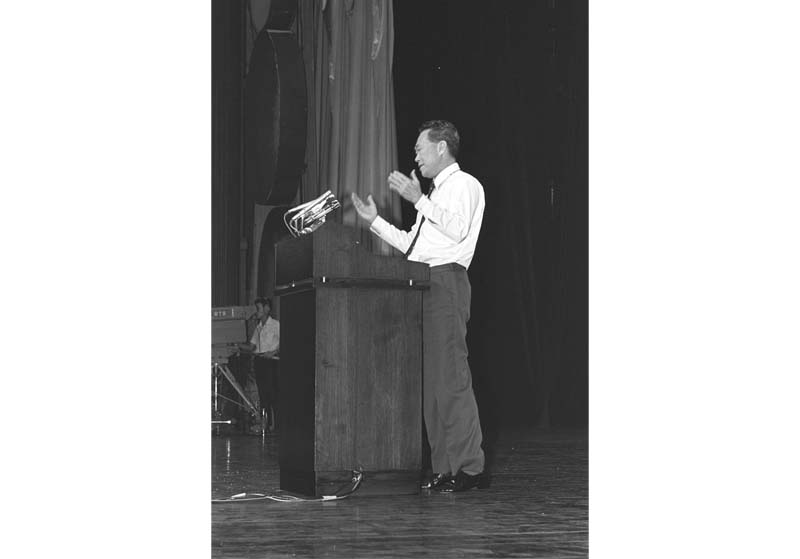 Former Prime Minister Lee Kuan Yew addressing the 3,500-strong audience during the 1971 National Day concert and rally held at the National Theatre. MITA collection, courtesy of National Archives of Singapore.
Former Prime Minister Lee Kuan Yew addressing the 3,500-strong audience during the 1971 National Day concert and rally held at the National Theatre. MITA collection, courtesy of National Archives of Singapore.Goh Chok Tong’s and Lee Hsien Loong’s rally speeches were more open, consultative and gentle compared to Lee Kuan Yew’s. In fact, Goh regularly used humorous colloquial dialect expressions to lighten up his speeches.40 For example, while commenting on the pragmatism of some graduates in choosing to become hawkers in a tough job market, Goh said in his 2003 rally:
“This is good. We must be practical – as practical as Teochew fishermen. They would say: ‘Kah tak hoi, chew liak her. Hoi zao, her liu, aiyah, bor her hay ah hor’ (Catch crabs with your feet and fish with your hands. But if the crabs run away and the fish slip through your hands, prawns will do just fine). Some graduates have also taken to roasting gao luk or chestnuts, for a living. Others are running their own porridge stall. I commend their attitude. They did not sit around and moan and groan. They went out and made a living for themselves. To Singaporeans who say this is a loss of face, I offer this Hokkien advice: ‘Lao quee buay xi, bo quee jia eh xi ‘ (Loss of face will not kill you, you will only die if you lose your breath).”41
Current prime minister, Lee Hsien Loong, makes a distinct effort to name ordinary Singaporeans as role models in his speeches.42 For example, in the 2013 rally, he shared the story of Dr Yeo Sze Ling who overcame her visual disability to become a research scientist at A*STAR. He said:
“…I thought I should tell you about her. Dr Yeo Sze Ling became blind at the age of four. She studied at the Singapore School for the Visually Handicapped. She did not go to a brand name school. She went to Bedok South Secondary School, Serangoon JC. She had an interest in mathematics, she was good at it, she read mathematics in NUS and she graduated with three degrees, including a PhD in Math… She topped the Faculty of Science in her year, now she is a research scientist at A*STAR and an Adjunct Assistant Professor at NTU… But she is not just a successful professional, she is volunteering at the Society for the Physically Disabled, helping others to overcome their disabilities, which is why she richly deserved to win the Singapore Youth Award last year where I met her… Sze Ling proves that you can do well if you work hard. It does not matter what your circumstances are…”43
Despite a change in the political climate and the subsequent tone of today’s rally speeches, they continue to serve as part of the larger National Day celebrations and as a platform for Singaporeans to reflect on their identity.
NDP 2015: The Big Bang
In 2015, Singapore will celebrate its 50th year as an independent nation. To mark this important milestone, an SG50 committee was announced in August 2013 to coordinate the country’s Golden Jubilee celebrations. The celebrations will not focus solely on the parades but rather a whole year of activities and events. To this end, a seed fund that provides up to S$50,000 was set up to help those interested in organising their own projects to celebrate their love for the nation. In addition, the SG50 committee has been collecting ideas from the public on how the anniversary celebrations should take shape.
Due to this ground-up approach, it is likely that the celebrations in 2015, including the NDP, may be different from previous years. However, it is certain that the impressive visual spectacle associated with past NDPs will take centre stage. Rest assured, whether in the form of parades, flags or rallies, the celebration will serve to remind Singaporeans of their national identity and obligations as well as provide an opportunity to reflect on how far Singapore has come.
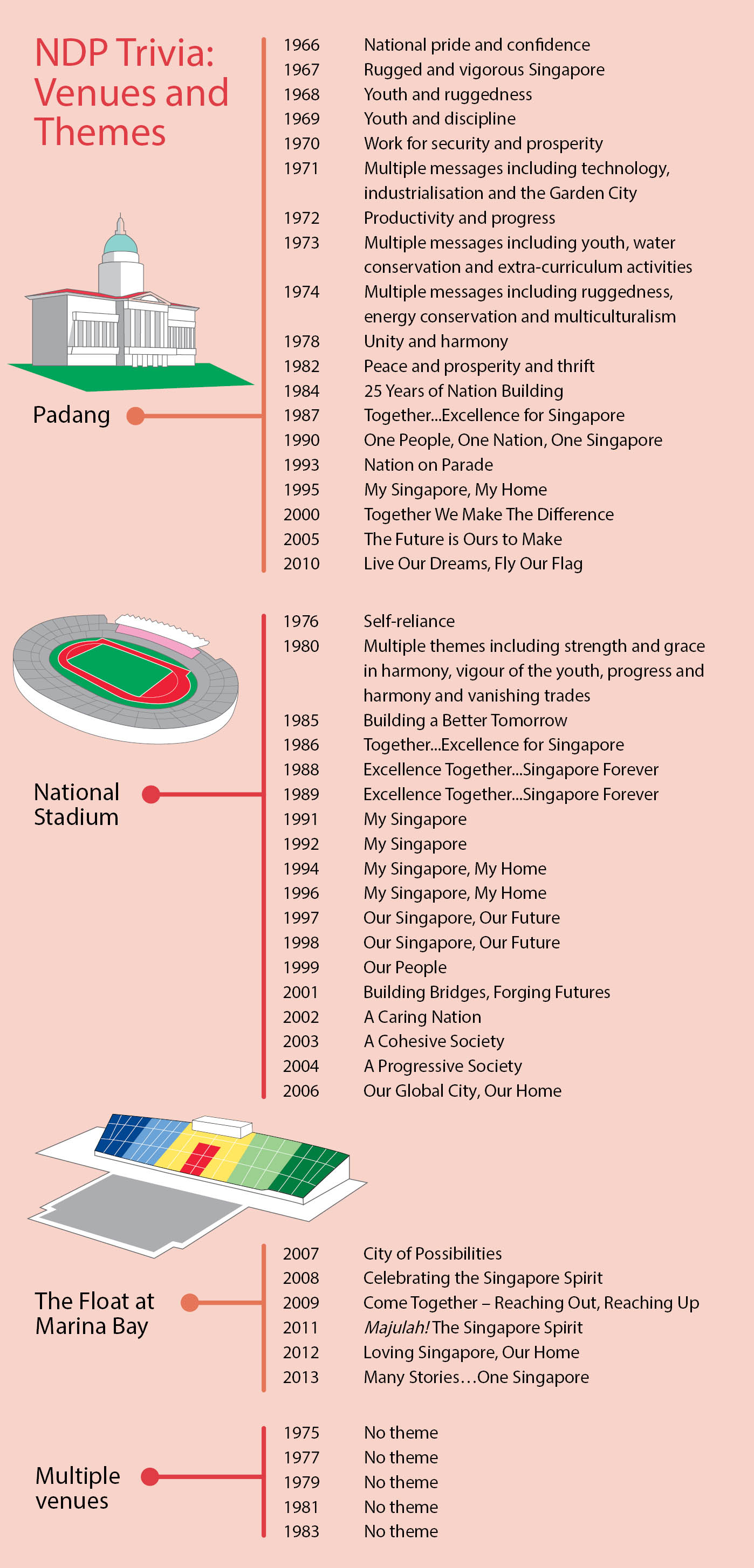
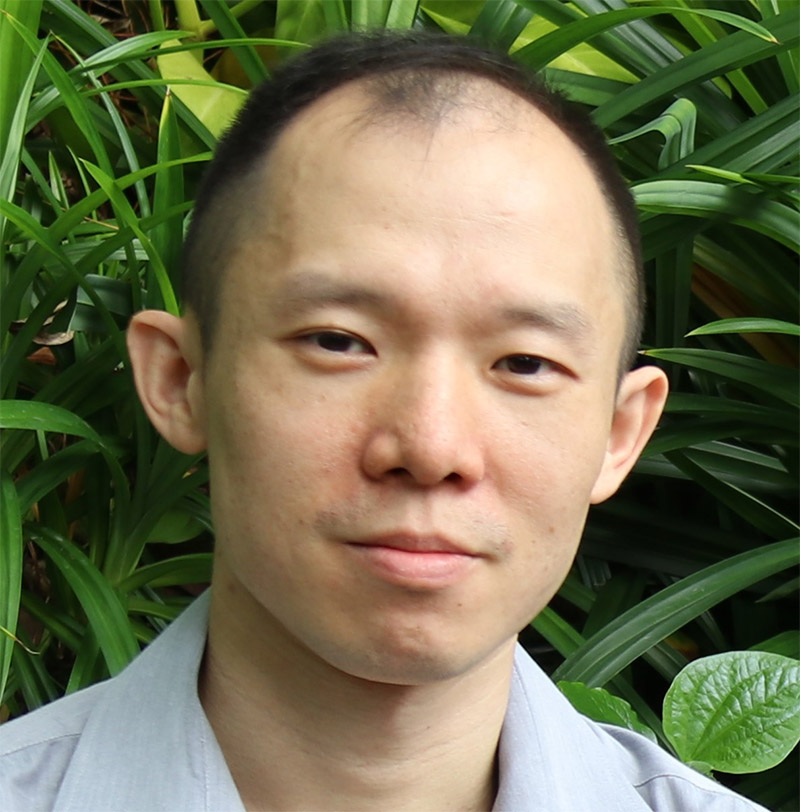
Lim Tin Seng is a Librarian with the National Library of Singapore. He is the co-editor of Roots: Tracing Family Histories – A Resource Guide (2013); Harmony and Development: ASEAN-China Relations (2009) and China’s New Social Policy: Initiatives for a Harmonious Society (2010).
REFERENCES
Barr, M.D. (2002). Cultural politics and Asian values: The tepid war. London: New York, N.Y.: Routledge. (Call no.: RSING 303.372095 BAR)
Fraser & Neave & Ministry of Communications and Information. (1988). Sing Singapore: A celebration in song, National Day 1988. Singapore: F&N Sarsi. (Call no.: RCLOS 782.42095957 SIN
Koh, B.C. (2006). Our global city our home: NDP 2006, our journey in pictures. Singapore: NDP 2006 EXCO. (Call no.: RSING 394.26845957 OUR)
Leong, W.T.L. (2001, December). Consuming the nation: National Day Parades in Singapore. New Zealand Journal of Asia Studies, 3 (2), 5–16. Retrieved from The New Zealand Asian Studies Society website.
My Singapore: National Day parade 1991: Memories. (1991). Singapore: National Day Parade Executive Committee, Souvenir Programme Sub-Committee. (Call no.: RSING 394.26845957 MY)
National Day celebrations: [Souvenir programme]. (1987). Singapore: Al-Marh-Ad. (Call no.: RSING 394.26845957 NAT)
National Day Parade 1996: My Singapore, my home. (1996). Singapore: National Day Parade Executive Committee, Commemorative Magazine Sub-Committee. (Call no.: RSING 959.57 NAT)
National Day Parade 1997: Commemorative magazine. (1997). Singapore: National Day Parade Executive Committee, Commemorative Magazine Sub-Committee. (Call no.: RSING q959.57 NAT)
National Day Parade 2001: Building bridges, forging futures. (2001). Singapore: National Day Parade 2001 Executive Committee. (Call no.: RSING 959.57 NAT)
National Day Parade 2005. (2005). Singapore: MediaCorp Publishing. (Call no.: RSING 959.5705 NAT)
National Day Parade 9th August, 1969. (1969). Singapore: Ministry of the Interior and Defence. (Call no.: RCLOS 959.57 NAT)
National Day Parade 9th August, 1968. (1968). Singapore: Ministry of the Interior and Defence. (Call no.: RCLOS 959.5705 NAT)
National Day Parade 9th August, 1972. (1972). Singapore: Ministry of the Interior and Defence. (Call no.: RCLOS 959.5705 NAT)
National Day Parade: [Programme]. (1967). Singapore: [s.n.]. (Microfilm no.: NL11208)
NDP 98: Celebrating 33 years of independence: Stories behind the story. (1998). Singapore: NDP 1998 EXCO. (Call no.: RSING 959.57 NDP)
NDP 2003: Celebrating as one united people. (2003). Singapore: NDP 2003 EXCO. (Call no.: RSING 959.57 NDP)
Our passion, our commitment: A tribute to the people behind NDP 04. (2004). Singapore: NDP 2003 EXCO. (Call no.: RSING 959.57 OUR)
Our people: Together we make the difference: NDP 99 commemorative magazine. (1999). Singapore: National Day Celebrations Committee. (Call no.: RSING 959.51 PEA)
Pearson, H.F. (1954). Stories of early Singapore. London: University of London Press. (Call no.: RCLOS 959.51 PEA)
Peet, G.L. (2009). Rickshaw reporter. Singapore: Marshall Cavendish Editions. (Call no.: RSING 070.92 PEE)
Rain…rain…rain. (1960, June 4). The Straits Times, p. 1. Retrieved from NewspaperSG.
Republic of Singapore National Day Parade: 9th August 1984: Souvenir programme. (1984). Singapore: Public Affairs Dept, Ministry of Defence. (Call no.: RSING 959.57 REP)
Republic of Singapore nineteen sixty-five [to] nineteen ninety. (1990). Singapore: National Day Parade Executive Committee, Programme & Printing Sub-Committee. (Call no.: RSING 394.26845957 REP)
Salma Khalik. (1987, August 8). Remembering parades past. The Straits Times, p. 2. Retrieved from NewspaperSG.
Tan, K.P. (2007). Singapore National Day Rally speech: A site of ideological negotiation. Journal of Contemporary Asia, 37 (3), 292─308, pp. 293–308. Retrieved from Taylor & Francis Online website.
Tattoo thrills at the stadium. (1960, June 5). The Straits Times, p. 1. Retrieved from NewspaperSG.
The NDP journey: Commemorating National Day Parade 2002. (2002). Singapore: NDP 2002 EXCO. (Call no.: RSING 959.57 NDP)
Volcic, Z., & Andrejevic, M. (2011). Nation branding in the era of commercial nationalism. International Journal of Communication, 5, pp. 598–618.
NOTES
-
Peet, G.L. (2009). Rickshaw reporter (pp. 36–37). Singapore: Marshall Cavendish Editions. (Call no.: RSING 070.92 PEE); Pearson, H.F. (1954). Stories of early Singapore (pp. 31–41). London: University of London Press. (Call no.: RCLOS 959.51 PEA) ↩
-
Salma Khalik. (1987, August 8). Remembering parades past. The Straits Times, p. 2. Retrieved from NewspaperSG. ↩
-
Singapore rugged society. (1967, April 21). TIME, 89 (16), p. 64. Retrieved from EBSCOHost via NLB’s eResources website; Barr, M.D. (2002). Cultural politics and Asian values: The tepid war (pp. 32–33). London: New York, N.Y.: Routledge. (Call no.: RSING 303.372095 BAR) ↩
-
National Day decorations theme is our rugged society. (1967, August 4). The Straits Times, p. 8; Sam, J., & Yong, J. (1968, August 10). The rugged society’s day. (1968, August 10). The Straits Times, p. 1; Sam, J. (1968, August 9). Youth and discipline. The Straits Times, p. 25. Retrieved from NewspaperSG. ↩
-
The Straits Times, 10 Aug 1968, p. 1; Upcoming channel 8 drama to relive 1968 NDP. (2012, July 12). Channel NewsAsia. Retrieved from Factiva via NLB’s eResources website. ↩
-
Sam, J. (1969, August 10). Armour leads the big parade. The Straits Times, p. 1. Retrieved from NewspaperSG. ↩
-
Leong, W.T.L. (2001, December). Consuming the nation: National Day Parades in Singapore. New Zealand Journal of Asia Studies, 3 (2), 5–16, pp. 6–8, Retrieved from The New Zealand Asian Studies Society website. ↩
-
Spectators watch splendour of parade as marchers, floats take six-km route. (1976, August 10). The Straits Times, p. 9. Retrieved from NewspaperSG. ↩
-
Leong, Dec 2001, pp. 6–8. ↩
-
Leong, Dec 2001, pp. 6–8. ↩
-
Leong, Dec 2001, pp. 6–8. ↩
-
Leong, Dec 2001, pp. 6–8; Peterson, W. (2001). Theater and the politics of culture in contemporary Singapore (pp. 77–82). Middletown, CT.: Wesleyan University Press. (Call no.: RSING 792.095957 PET) ↩
-
Fraser & Neave & Ministry of Communications and Information. (1988). Sing Singapore: A celebration in song, National Day 1988 (p. i). Singapore: F&N Sarsi. (Call no.: RCLOS 782.42095957 SIN) ↩
-
‘Surprise’ collection points to beat queues. (2002, June 27). The Straits Times, p. 4. Retrieved from NewspaperSG. ↩
-
Wee, C.Y. (2008, August 12). On parade. The Straits Times, p. 92. Retrieved from NewspaperSG. ↩
-
Sam, J., Perstans, R., & Yong, J. (1966, August 10). The big parade on the padang. The Straits Times, p. 1. Retrieved from NewspaperSG. ↩
-
Colourama. (1975, July 14). The Straits Times, p. 11. Retrieved from NewspaperSG. ↩
-
Parades at 13 centres to mark 10th birthday. (1975, August 10). The Straits Times, p. 1. Retrieved from NewspaperSG. ↩
-
The Straits Times, 10 Aug 1975, p. 1. ↩
-
The Straits Times, 10 Aug 1975, p. 1. ↩
-
Leong, Dec 2001, p. 7. ↩
-
Fang, J. (2010, July 16). Mini-NDPs to be held at five heartland areas. My Paper. Retrieved from Factiva via NLB’s eResources website. ↩
-
My Paper, 16 Jul 2010. ↩
-
Chow, J. (2010, August 10). This is truly home. (2010, August 10). The Straits Times, p. 1. Retieved from NewspaperSG; MPs celebrate National Day with constituencies. (2010, August 10). The Straits Times. Retrieved from Factiva via NLB’s eResources website; Home is where the heart is. (2010, August 10). The Straits Times, p. 10. Retrieved from NewspaperSG. ↩
-
Ministers and MPs seen in uniform by the public for the first time. (1966, August 10). The Straits Times, p. 6; Rush for colour TV sets to watch N-Day parade. (1974, August 8). The Straits Times, p. 15. Retrieved from NewspaperSG. ↩
-
S’poreans overseas can watch N-Day parade live on PCs. (1994, August 4). The Straits Times, p. 4. Retrieved from NewspaperSG. ↩
-
Chuah, D. (2007, July 11). Watch this year’s NDP live from wherever you are. Today, p. 9. Retrieved from NewspaperSG. ↩
-
NDP 2010 at your fingertips. (2010, May 12). Youth.SG Retrieved from Youth.SG website: ↩
-
Yong, N. (2009, July 22). NDP fever goes to the heartland before big day. The Straits Times, p. 22. Retrieved from NewspaperSG. ↩
-
See Koh, B.C. (2006). Our global city our home: NDP 2006, our journey in pictures. Singapore: NDP 2006 EXCO. (Call no.: RSING 394.26845957 OUR); NDP 98: Celebrating 33 years of independence: Stories behind the story. (1998). Singapore: NDP 1998 EXCO. (Call no.: RSING 959.57 NDP) and other publications mostly by NDP EXCO (Executive Committee) for commemorative publications on previous NDPs. ↩
-
See Volcic, Z., & Andrejevic, M. (2011). Nation branding in the era of commercial nationalism. International Journal of Communication, 5, pp. 598–618 for approaches to branding and marketing the nation. ↩
-
State flags are flying high even before official go-ahead is given. (1988, July 28). The Straits Times, p.14. Retrieved from NewspaperSG. ↩
-
Leong, Dec 2001, p. 10. ↩
-
Tan, S., & Zuraidah Ibrahim. (1990, August 26). PM caps 25-year tradition of talking to Singaporeans. The Straits Times, p. 2. Retrieved from NewspaperSG. ↩
-
Tan, K.P. (2007). Singapore National Day Rally speech: A site of ideological negotiation. Journal of Contemporary Asia, 37 (3), 292─308, pp. 293–294. Retrieved from Taylor & Francis Online website. ↩
-
Tan, 2007, pp. 293–294. ↩
-
Tan, 2007, pp. 293–294. ↩
-
The Straits Times, 26 Aug 1990, p. 2. ↩
-
Lee on the need to inculcate right attitudes and values. (1971, August 21). The Straits Times, p. 10. Retrieved from NewspaperSG. ↩
-
Tan, 2007, p. 297. ↩
-
Ministry of Information, Communications and Arts. (2003, August 17). Speech by Prime Minister Goh Chok Tong at the National Day Rally 2003 [Speech]. Retrieved from National Archives of Singapore website. ↩
-
Tan, 2007, p. 297. ↩
-
Prime Minister’s Office. (2013, August 18). Prime Minister Lee Hsien Loong’s National Day Rally 2013. Retrieved from Prime Minister’s Office website. ↩

